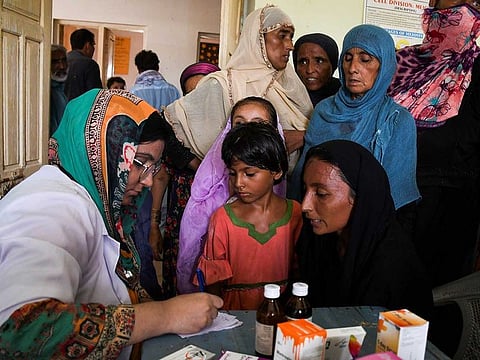Pakistan launches digital flood dashboard to ensure transparency
Sindh CM says it will take three to six months to drain flood water

Islamabad: The Pakistan government has launched a ‘Digital Flood Dashboard’ to ensure transparency and accountability of flood relief funds.
Planning Minister Ahsan Iqbal launched the digital dashboard of the National Flood Response Coordination Center (NFRCC) on Monday. The dashboard will make public all information regarding donations received, distribution, and delivery of relief goods among the flood victims, he said.
Every effort for relief and rehabilitation will be done in a transparent way. This digital forum will ensure transparency of donations by Pakistanis, international aid as well as flood relief effort by friendly countries, everything will be available on this portal for our citizens and development partners” said Iqbal.
PM vows to make floods fund transparent
Pakistan’s government has said that it intends to spend the aid money with full accountability. Prime Minister Shehbaz Sharif would personally supervise the digital dashboard as he has pledged that “every penny of donations collected for the flood victims will be spent in a very transparent manner and will reach the needy.” The prime minister also said that the Accountant General Pakistan Revenues (AGPR) and an international-repute audit firm “will audit all incoming and outgoing funds including where and how the money is spent” and the audit reports will be made public.
Disaster of epic proportions
Minister Ahsan Iqbal urged the public to step forward and continue to help the flood victims as one-third of Pakistan is facing climate catastrophe.
Floods from record monsoon rains have affected 33 million people and killed almost 1,400, including almost 500 children. The catastrophic floods have ruined lives, swept away roads and infrastructure, destroyed over one million homes and crops, killed livestock, and wiped out livelihoods.
Murad Ali Shah, the chief minister of the worst-affected Sindh province, said that it would take three to six months to drain flood water from areas, saying the scale of monsoon rains was unprecedented this year. Shah said that Sindh province needs tents for over 12.5 million people as there are still “thousands of families who do not have shelter and are living under the sky.”
“The scale of damages and destruction due to devastating monsoon floods is like none seen before in the history of Pakistan,” says Ishfaq Anwar, country director of Relief International, one of the many NGOs working on the ground to offer support to the flood-hit communities. “Over 33 million people are waiting for life-saving assistance and we as humanitarian professionals should do whatever we can in our capacity. We look forward to the national and international community coming out and contributing to this noble cause as the people are in need” he said. Anwar said that his organisation has conducted a rapid need assessment which shows that affected people in target districts immediately need temporary shelters, food, health assistance, cash assistance, psycho-social support assistance, and menstrual hygiene management kits for women and girls.
The government and international community “will need to focus on rehabilitation of livelihood opportunities, nutrition assistance, particularly for infant and pregnant women, shelters, rehabilitation of health facilities and services, and rehabilitation of schools and WASH facilities,” he added.
UN and Pakistan government jointly issued a flash appeal for $160 million to help millions cope with floods. Last week, UN Secretary-General Antonio Guterres travelled to flood-hit areas of Pakistan and called on the world to stop “sleepwalking” through the dangerous environmental crisis. UN chief has called for massive international support for flood-ravaged Pakistan and has put the cost of flood-related damage at $30 billion.
Sign up for the Daily Briefing
Get the latest news and updates straight to your inbox



